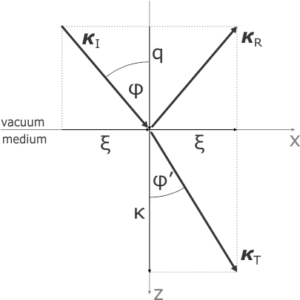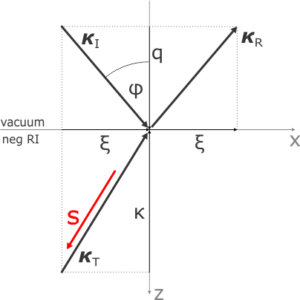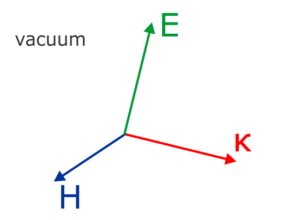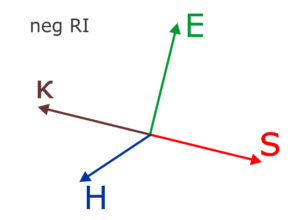$\setCounter{0}$
Part 1: The wave vector
Part 2: The interface
Part 3: The s-polarization
Part 4: The p-polarization
Part 5: Multilayers
Here we will start to do things bit differently. For the p-polarization, the electric field vector lies in the plane of incidence and the magnetic field has only y-component. Consider the following figure:
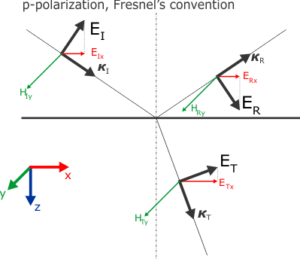
The usual textbook definition of p-polarized Fresnel’s coefficients is \(r_p = E_{Rp}/E_{Ip} \) and \(t_p = E_{Tp}/E_{Ip} \), where the amplitudes \(E_{jp}\) are measured in the right-handed \(\boldsymbol\kappa,\mathbf{P},\mathbf{S}\) basis attached to the beams, so the reflected p-polarized direction is opposite from we have here (see Fresnel vs Verdet blog).
We will define here the \(r_p = E_{Rx}/E_{Ix} \) in terms of x-components, which is, in Fresnel’s convention,
\(
\begin{align*}
r_p = \frac{E_{Rx}}{E_{Ix}} \equiv \frac{E_{Rp}}{E_{Ip}},
\end{align*}
\)
since the angle of reflection is equal to angle of incidence. We will, however, define the transmission coefficient as
\(
\begin{align}
t_{px} = \frac{E_{Tx}}{E_{Ix}},
\end{align}
\)
and keep the index \(px\) to highlight that this definition differs from the textbook \(t_p\). We should not have any trouble with this definition, since in typical ellipsometry experiment, we do not measure the transmitted beam, and if we do, we do it back again in the ambient medium, so the angle of refraction is the same as angle of incidence, assuming of course we have planar and parallel interfaces on our sample.
We have two conditions for matching the in-plane field components:
\(
\begin{align}
\begin{aligned}
E_{Ix}+E_{Rx} &= E_{Tx},
\\
H_{Iy}+H_{Ry} &= H_{Ty},
\end{aligned}\label{eqFieldMatchP}
\end{align}
\)
So, dividing first with \(E_{Ix}\) we obtain
|
\( \begin{align}\label{eqDefCoefsP} 1+r_{p} &= t_{px}. \end{align} \) |
where, thanks to the \(t_{px}\) definition and Fresnel’s convention, we’ve got condition analogical to the Part 3 eq. (2) valid for the s-polarization. We will also proceed in the same way, that is we will find the \(r_p\) and calculate \(t_{px}\) using \eqref{eqDefCoefsP}.
Using second Maxwell’s equation in the form of eqs. (9) in Part 1:
\(
\begin{align}
\varepsilon_j\mathbf{E}_j = – \boldsymbol\kappa_j \times \mathbf{H}_j = (\kappa_j H_{jy}, 0 ,-\xi H_{jy}),
\end{align}
\)
where again \( j = I,R,T \) and \( \kappa_I \equiv q \), \( \kappa_R \equiv -q \), \( \kappa_T \equiv \kappa \). We get the components explicitly
\(
\begin{align}
\begin{aligned}
E_{Ix} &= q H_{Iy},
& E_{Iz} &= – \xi H_{Iy},
\\
E_{Rx} &= – q H_{Ry},
& E_{Rz} &= – \xi H_{Ry},
\\
E_{Tx} &= \frac{\kappa H_{Ty}}{\varepsilon},
& E_{Tz} &= – \frac{\xi H_{Ty}}{\varepsilon},
\end{aligned}\label{eqHEcomponents}
\end{align}
\)
from where we get that \(r_p = E_{Rx}/E_{Ix} = – H_{Ry}/H_{Iy} \), so we take the first equation of \eqref{eqFieldMatchP}, replace the \(E_{jx} \) and have
\(
\begin{align*}
\varepsilon q H_I – \varepsilon q H_R = \kappa H_T,
\end{align*}
\)
where we dropped the \(y\) index. Finally, we use the second equation of \eqref{eqFieldMatchP} to get rid of the \(H_{T}\):
\(
\begin{align*}
\begin{aligned}
\varepsilon q H_I – \varepsilon q H_R &= \kappa H_I + \kappa H_R,
\\
(\varepsilon q – \kappa ) H_I &= (\varepsilon q + \kappa ) H_R.
\end{aligned}
\end{align*}
\)
Merrily getting the \(r_p\):
|
\( \begin{align} r_p = \frac{E_{Rx}}{E_{Ix}} = – \frac{H_{R}}{H_{I}} = \frac{ \kappa – \varepsilon q }{ \kappa + \varepsilon q }, \end{align} \) |
and the \( t_{px} \) is obtained from \eqref{eqDefCoefsP}:
|
\( \begin{align} t_{px} = 1 + r_p = 1 + \frac{ \kappa – \varepsilon q }{ \kappa + \varepsilon q } = \frac{ 2 \kappa}{ \kappa + \varepsilon q }, \end{align} \) |
And that’s it. We have derived the Fresnel’s coefficients in terms of the in-plane (\(x,y\)) components of the electric field amplitudes. We will see later that Berreman’s theory of light propagating in layers of very general electromagnetic media uses the same approach, so we will be rewarded with consistent framework.
Let me add some slightly confusing remarks here. Question is: what would happen, if we try to define the coefficients for p-polarization in terms of the \(H_{jy}\) field amplitudes, i.e. abusing the fact that \(\bf{H_j}\) have only y-components. We have a look on the second equation of \eqref{eqFieldMatchP}. Sure we can divide it by \(H_{Iy}\), getting:
\(
\begin{align*}
1 + \frac{H_{Ry}}{H_{Iy}} &= \frac{H_{Ty}}{H_{Iy}},
\\
1 + r_H &= t_H,
\end{align*}
\)
where we defined new pair of coefficients \( r_H \), \( t_H \). Using our results above, we get
\(
\begin{align*}
r_H = \frac{ \varepsilon q – \kappa}{ \varepsilon q + \kappa },\quad
t_H = \frac{ 2 \varepsilon q}{ \varepsilon q + \kappa }.
\end{align*}
\)
In this form we have pair of coefficients, which is completely symmetric with the \(r_s\), \(t_s\) from Part 3, if we exchange \( \varepsilon \) and \( \mu \). Which is nice, but would turn too disruptive later, when we will write the general Jones matrix with cross-polarization elements. Note that such \(r_H\) is also equivalent to \(r_p\) written in the Verdet’s convention, as it usually appears in textbooks.
So what is the textbook \(t_{pB}\) (here with index \(B\) as book)? It should be defined in terms of p-amplitudes of electric fields as \(t_{pB} = E_{Tp}/E_{Ip} \), so it assumes that we can define the
\(
\begin{align*}
E_{Tp} \equiv \sqrt{{E_{Tx}}^2 + {E_{Tz}}^2} = \frac{H_{Ty}}{\varepsilon} \sqrt{{\kappa}^2 + {\xi}^2} = \frac{H_{Ty}}{\varepsilon} \sqrt{\varepsilon \mu},
\end{align*}
\)
where we used the components from \eqref{eqHEcomponents}, while \(E_{Ip} = H_{Iy} \) in vacuum. So
\(
\begin{align*}
t_{pB} = \frac{E_{Tp}}{E_{Ip}} = \frac{H_{Ty}}{H_{Iy}} \frac{\sqrt{\varepsilon \mu}}{\varepsilon} = t_H \frac{\sqrt{\varepsilon \mu}}{\varepsilon} = \frac{ 2 \sqrt{\varepsilon \mu} q}{ \varepsilon q + \kappa }.
\end{align*}
\)
Madness. Mostly, I don’t like that here we no longer have the simple coupling \( 1+r=t\).

